ACF713SU - Next PLC Financial Performance Report: 2016 and 2017
VerifiedAdded on 2023/06/14
|11
|2727
|468
Report
AI Summary
This report provides a comprehensive analysis of Next PLC's financial performance for the years 2016 and 2017, based on their annual reports and website disclosures. It examines the extent of financial information disclosed, covering aspects like the basis of financial reporting, compliance with IFRS, and consolidation practices. The report then delves into a comparative analysis of the company's performance, scrutinizing the income statement, balance sheet, and cash flow statement. Key findings include a slight decline in total sales revenue, profit before tax, and earnings per share in 2017 compared to 2016. Despite these declines, the company maintained a strong cash flow and returned a significant amount of capital to shareholders. The analysis also highlights the performance of Next PLC's subsidiaries and provides insights into the company's assets, liabilities, and overall financial health.
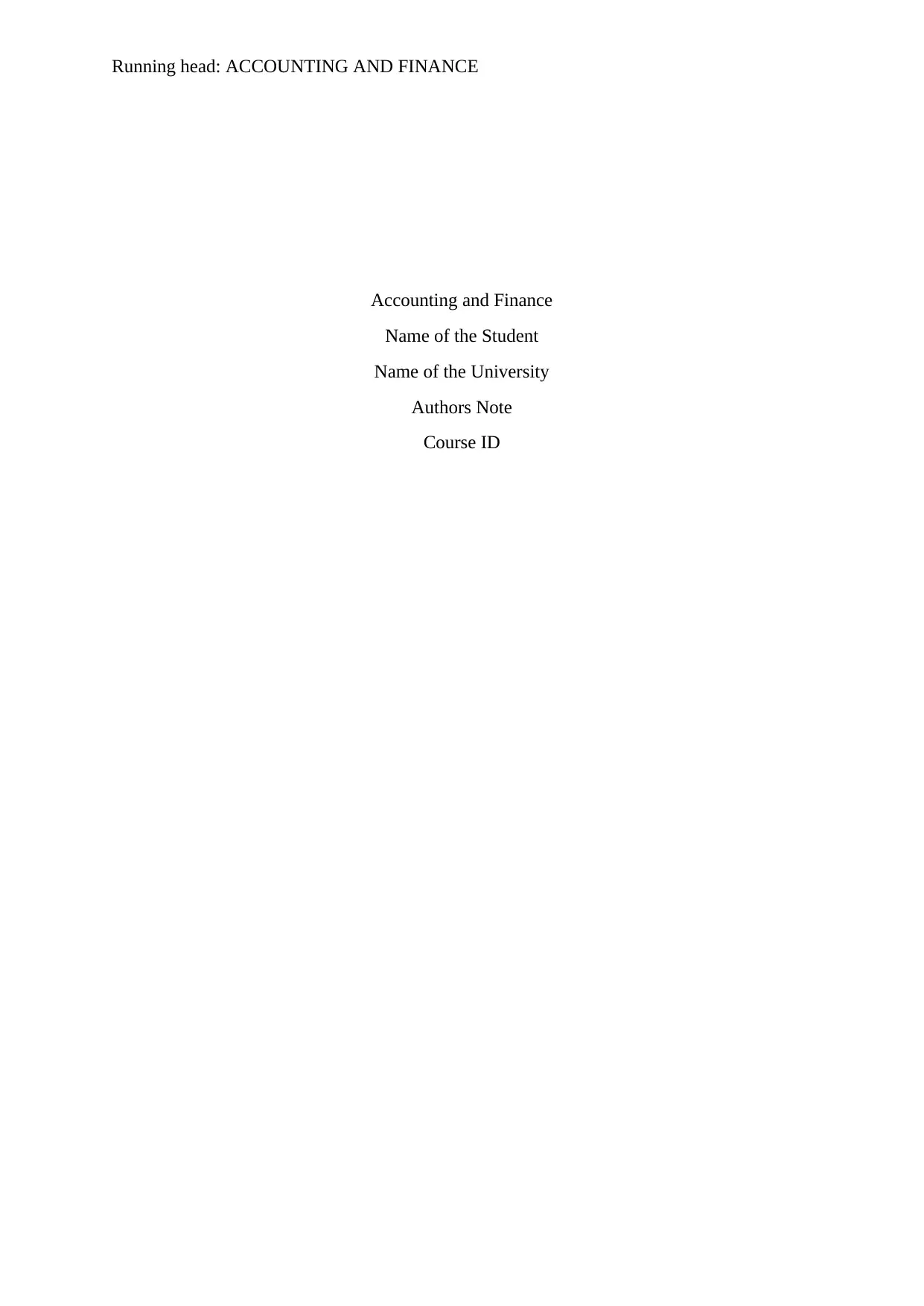
Running head: ACCOUNTING AND FINANCE
Accounting and Finance
Name of the Student
Name of the University
Authors Note
Course ID
Accounting and Finance
Name of the Student
Name of the University
Authors Note
Course ID
Paraphrase This Document
Need a fresh take? Get an instant paraphrase of this document with our AI Paraphraser
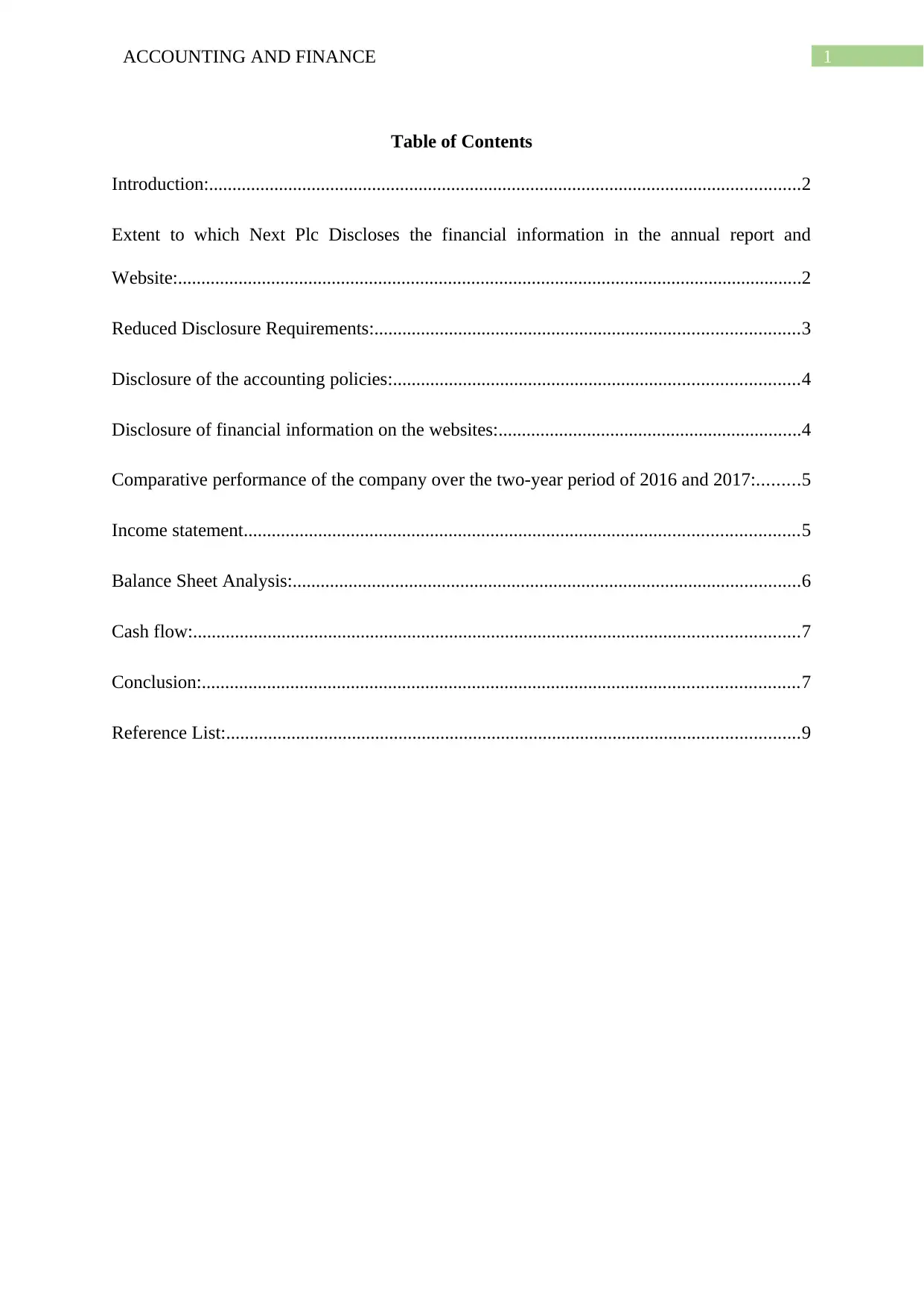
1ACCOUNTING AND FINANCE
Table of Contents
Introduction:...............................................................................................................................2
Extent to which Next Plc Discloses the financial information in the annual report and
Website:......................................................................................................................................2
Reduced Disclosure Requirements:...........................................................................................3
Disclosure of the accounting policies:.......................................................................................4
Disclosure of financial information on the websites:.................................................................4
Comparative performance of the company over the two-year period of 2016 and 2017:.........5
Income statement.......................................................................................................................5
Balance Sheet Analysis:.............................................................................................................6
Cash flow:..................................................................................................................................7
Conclusion:................................................................................................................................7
Reference List:...........................................................................................................................9
Table of Contents
Introduction:...............................................................................................................................2
Extent to which Next Plc Discloses the financial information in the annual report and
Website:......................................................................................................................................2
Reduced Disclosure Requirements:...........................................................................................3
Disclosure of the accounting policies:.......................................................................................4
Disclosure of financial information on the websites:.................................................................4
Comparative performance of the company over the two-year period of 2016 and 2017:.........5
Income statement.......................................................................................................................5
Balance Sheet Analysis:.............................................................................................................6
Cash flow:..................................................................................................................................7
Conclusion:................................................................................................................................7
Reference List:...........................................................................................................................9
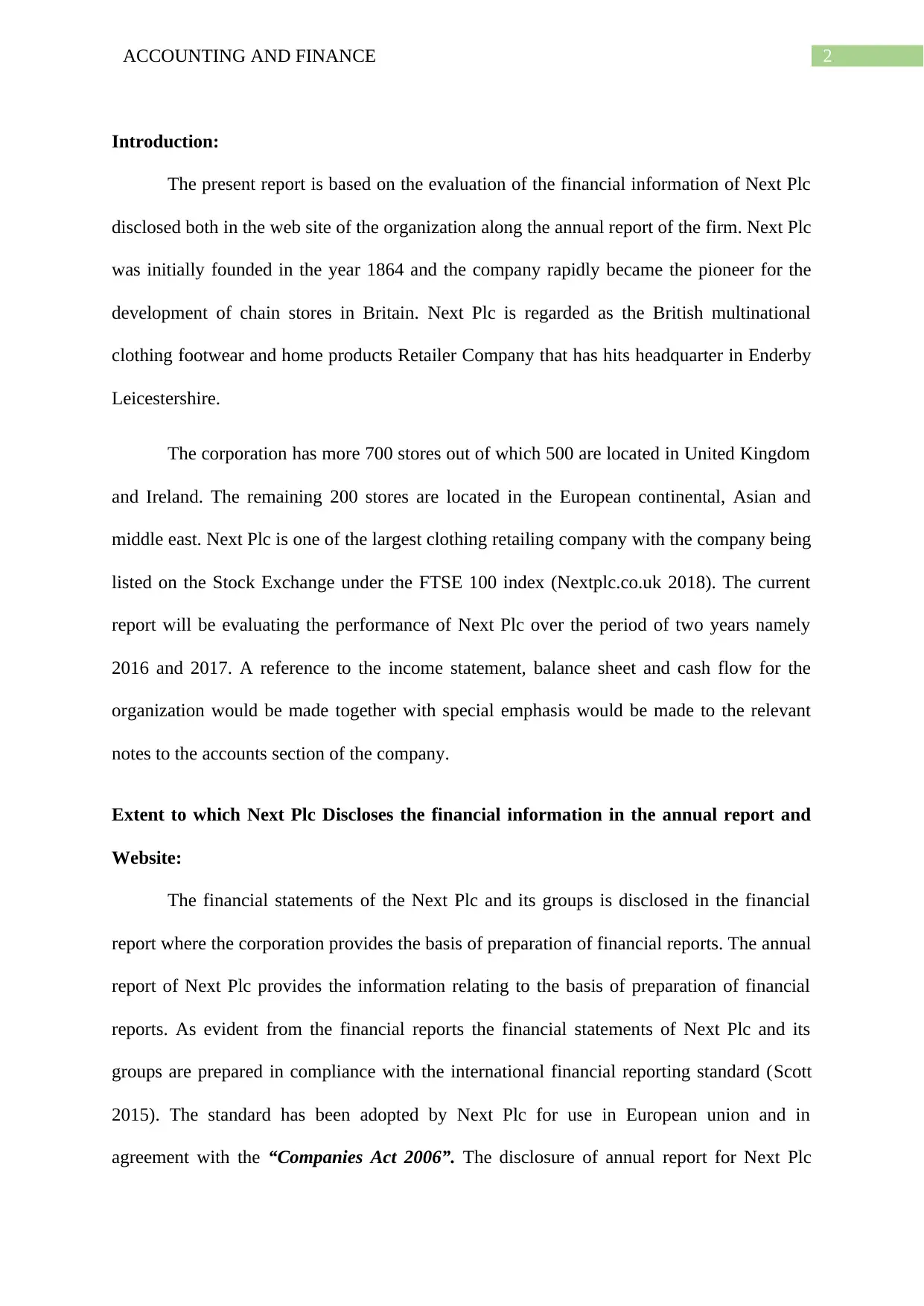
2ACCOUNTING AND FINANCE
Introduction:
The present report is based on the evaluation of the financial information of Next Plc
disclosed both in the web site of the organization along the annual report of the firm. Next Plc
was initially founded in the year 1864 and the company rapidly became the pioneer for the
development of chain stores in Britain. Next Plc is regarded as the British multinational
clothing footwear and home products Retailer Company that has hits headquarter in Enderby
Leicestershire.
The corporation has more 700 stores out of which 500 are located in United Kingdom
and Ireland. The remaining 200 stores are located in the European continental, Asian and
middle east. Next Plc is one of the largest clothing retailing company with the company being
listed on the Stock Exchange under the FTSE 100 index (Nextplc.co.uk 2018). The current
report will be evaluating the performance of Next Plc over the period of two years namely
2016 and 2017. A reference to the income statement, balance sheet and cash flow for the
organization would be made together with special emphasis would be made to the relevant
notes to the accounts section of the company.
Extent to which Next Plc Discloses the financial information in the annual report and
Website:
The financial statements of the Next Plc and its groups is disclosed in the financial
report where the corporation provides the basis of preparation of financial reports. The annual
report of Next Plc provides the information relating to the basis of preparation of financial
reports. As evident from the financial reports the financial statements of Next Plc and its
groups are prepared in compliance with the international financial reporting standard (Scott
2015). The standard has been adopted by Next Plc for use in European union and in
agreement with the “Companies Act 2006”. The disclosure of annual report for Next Plc
Introduction:
The present report is based on the evaluation of the financial information of Next Plc
disclosed both in the web site of the organization along the annual report of the firm. Next Plc
was initially founded in the year 1864 and the company rapidly became the pioneer for the
development of chain stores in Britain. Next Plc is regarded as the British multinational
clothing footwear and home products Retailer Company that has hits headquarter in Enderby
Leicestershire.
The corporation has more 700 stores out of which 500 are located in United Kingdom
and Ireland. The remaining 200 stores are located in the European continental, Asian and
middle east. Next Plc is one of the largest clothing retailing company with the company being
listed on the Stock Exchange under the FTSE 100 index (Nextplc.co.uk 2018). The current
report will be evaluating the performance of Next Plc over the period of two years namely
2016 and 2017. A reference to the income statement, balance sheet and cash flow for the
organization would be made together with special emphasis would be made to the relevant
notes to the accounts section of the company.
Extent to which Next Plc Discloses the financial information in the annual report and
Website:
The financial statements of the Next Plc and its groups is disclosed in the financial
report where the corporation provides the basis of preparation of financial reports. The annual
report of Next Plc provides the information relating to the basis of preparation of financial
reports. As evident from the financial reports the financial statements of Next Plc and its
groups are prepared in compliance with the international financial reporting standard (Scott
2015). The standard has been adopted by Next Plc for use in European union and in
agreement with the “Companies Act 2006”. The disclosure of annual report for Next Plc
⊘ This is a preview!⊘
Do you want full access?
Subscribe today to unlock all pages.

Trusted by 1+ million students worldwide
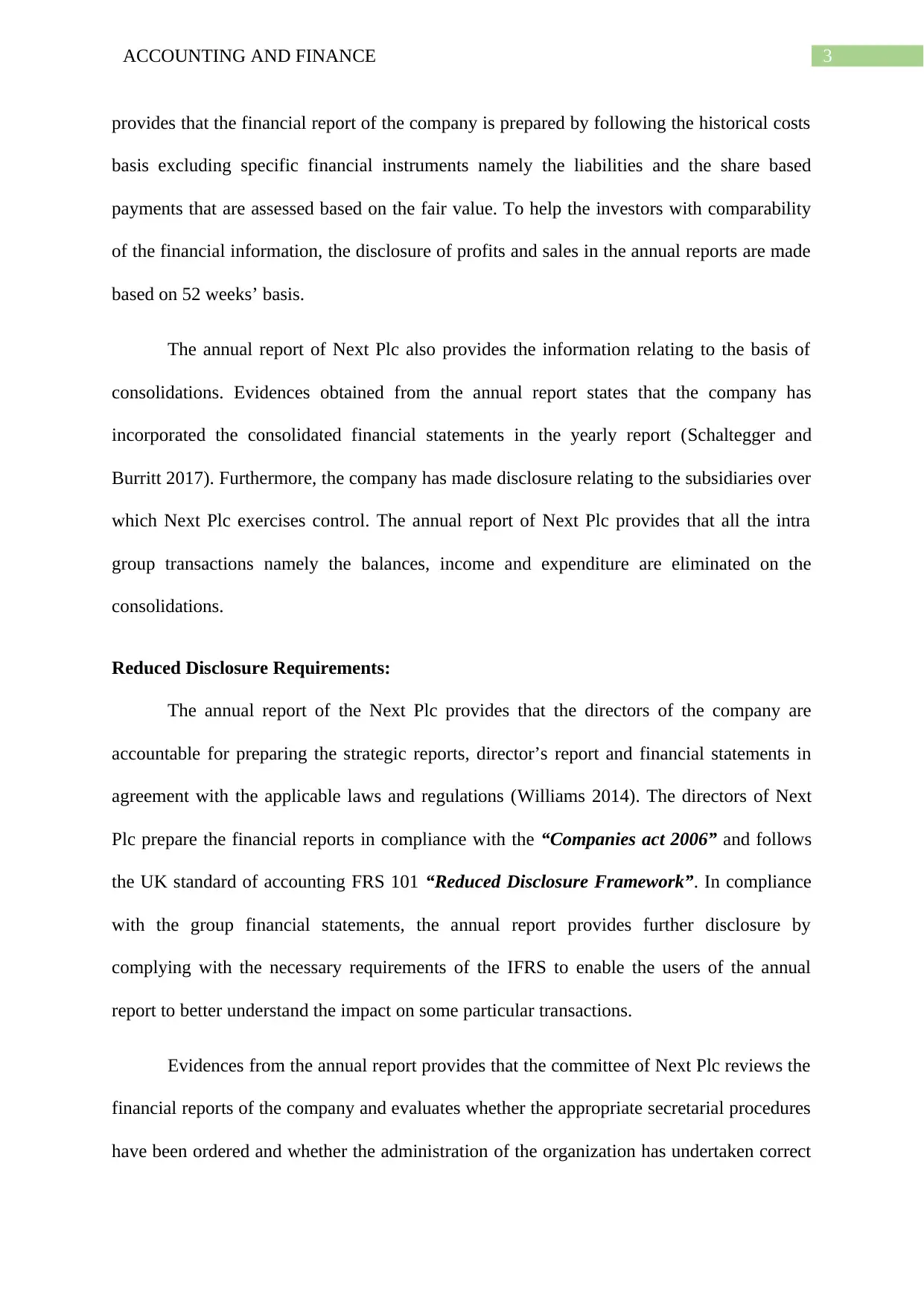
3ACCOUNTING AND FINANCE
provides that the financial report of the company is prepared by following the historical costs
basis excluding specific financial instruments namely the liabilities and the share based
payments that are assessed based on the fair value. To help the investors with comparability
of the financial information, the disclosure of profits and sales in the annual reports are made
based on 52 weeks’ basis.
The annual report of Next Plc also provides the information relating to the basis of
consolidations. Evidences obtained from the annual report states that the company has
incorporated the consolidated financial statements in the yearly report (Schaltegger and
Burritt 2017). Furthermore, the company has made disclosure relating to the subsidiaries over
which Next Plc exercises control. The annual report of Next Plc provides that all the intra
group transactions namely the balances, income and expenditure are eliminated on the
consolidations.
Reduced Disclosure Requirements:
The annual report of the Next Plc provides that the directors of the company are
accountable for preparing the strategic reports, director’s report and financial statements in
agreement with the applicable laws and regulations (Williams 2014). The directors of Next
Plc prepare the financial reports in compliance with the “Companies act 2006” and follows
the UK standard of accounting FRS 101 “Reduced Disclosure Framework”. In compliance
with the group financial statements, the annual report provides further disclosure by
complying with the necessary requirements of the IFRS to enable the users of the annual
report to better understand the impact on some particular transactions.
Evidences from the annual report provides that the committee of Next Plc reviews the
financial reports of the company and evaluates whether the appropriate secretarial procedures
have been ordered and whether the administration of the organization has undertaken correct
provides that the financial report of the company is prepared by following the historical costs
basis excluding specific financial instruments namely the liabilities and the share based
payments that are assessed based on the fair value. To help the investors with comparability
of the financial information, the disclosure of profits and sales in the annual reports are made
based on 52 weeks’ basis.
The annual report of Next Plc also provides the information relating to the basis of
consolidations. Evidences obtained from the annual report states that the company has
incorporated the consolidated financial statements in the yearly report (Schaltegger and
Burritt 2017). Furthermore, the company has made disclosure relating to the subsidiaries over
which Next Plc exercises control. The annual report of Next Plc provides that all the intra
group transactions namely the balances, income and expenditure are eliminated on the
consolidations.
Reduced Disclosure Requirements:
The annual report of the Next Plc provides that the directors of the company are
accountable for preparing the strategic reports, director’s report and financial statements in
agreement with the applicable laws and regulations (Williams 2014). The directors of Next
Plc prepare the financial reports in compliance with the “Companies act 2006” and follows
the UK standard of accounting FRS 101 “Reduced Disclosure Framework”. In compliance
with the group financial statements, the annual report provides further disclosure by
complying with the necessary requirements of the IFRS to enable the users of the annual
report to better understand the impact on some particular transactions.
Evidences from the annual report provides that the committee of Next Plc reviews the
financial reports of the company and evaluates whether the appropriate secretarial procedures
have been ordered and whether the administration of the organization has undertaken correct
Paraphrase This Document
Need a fresh take? Get an instant paraphrase of this document with our AI Paraphraser
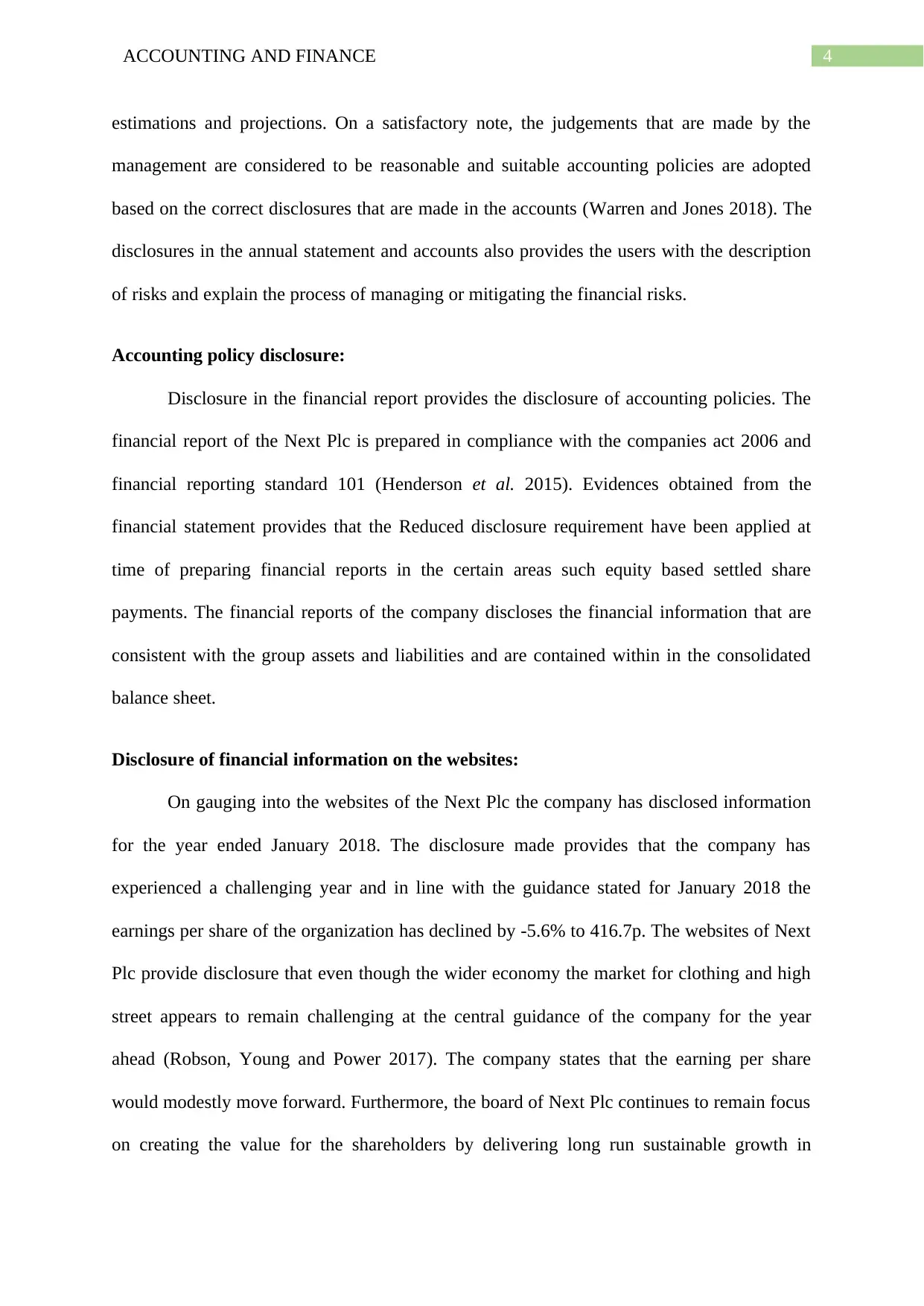
4ACCOUNTING AND FINANCE
estimations and projections. On a satisfactory note, the judgements that are made by the
management are considered to be reasonable and suitable accounting policies are adopted
based on the correct disclosures that are made in the accounts (Warren and Jones 2018). The
disclosures in the annual statement and accounts also provides the users with the description
of risks and explain the process of managing or mitigating the financial risks.
Accounting policy disclosure:
Disclosure in the financial report provides the disclosure of accounting policies. The
financial report of the Next Plc is prepared in compliance with the companies act 2006 and
financial reporting standard 101 (Henderson et al. 2015). Evidences obtained from the
financial statement provides that the Reduced disclosure requirement have been applied at
time of preparing financial reports in the certain areas such equity based settled share
payments. The financial reports of the company discloses the financial information that are
consistent with the group assets and liabilities and are contained within in the consolidated
balance sheet.
Disclosure of financial information on the websites:
On gauging into the websites of the Next Plc the company has disclosed information
for the year ended January 2018. The disclosure made provides that the company has
experienced a challenging year and in line with the guidance stated for January 2018 the
earnings per share of the organization has declined by -5.6% to 416.7p. The websites of Next
Plc provide disclosure that even though the wider economy the market for clothing and high
street appears to remain challenging at the central guidance of the company for the year
ahead (Robson, Young and Power 2017). The company states that the earning per share
would modestly move forward. Furthermore, the board of Next Plc continues to remain focus
on creating the value for the shareholders by delivering long run sustainable growth in
estimations and projections. On a satisfactory note, the judgements that are made by the
management are considered to be reasonable and suitable accounting policies are adopted
based on the correct disclosures that are made in the accounts (Warren and Jones 2018). The
disclosures in the annual statement and accounts also provides the users with the description
of risks and explain the process of managing or mitigating the financial risks.
Accounting policy disclosure:
Disclosure in the financial report provides the disclosure of accounting policies. The
financial report of the Next Plc is prepared in compliance with the companies act 2006 and
financial reporting standard 101 (Henderson et al. 2015). Evidences obtained from the
financial statement provides that the Reduced disclosure requirement have been applied at
time of preparing financial reports in the certain areas such equity based settled share
payments. The financial reports of the company discloses the financial information that are
consistent with the group assets and liabilities and are contained within in the consolidated
balance sheet.
Disclosure of financial information on the websites:
On gauging into the websites of the Next Plc the company has disclosed information
for the year ended January 2018. The disclosure made provides that the company has
experienced a challenging year and in line with the guidance stated for January 2018 the
earnings per share of the organization has declined by -5.6% to 416.7p. The websites of Next
Plc provide disclosure that even though the wider economy the market for clothing and high
street appears to remain challenging at the central guidance of the company for the year
ahead (Robson, Young and Power 2017). The company states that the earning per share
would modestly move forward. Furthermore, the board of Next Plc continues to remain focus
on creating the value for the shareholders by delivering long run sustainable growth in
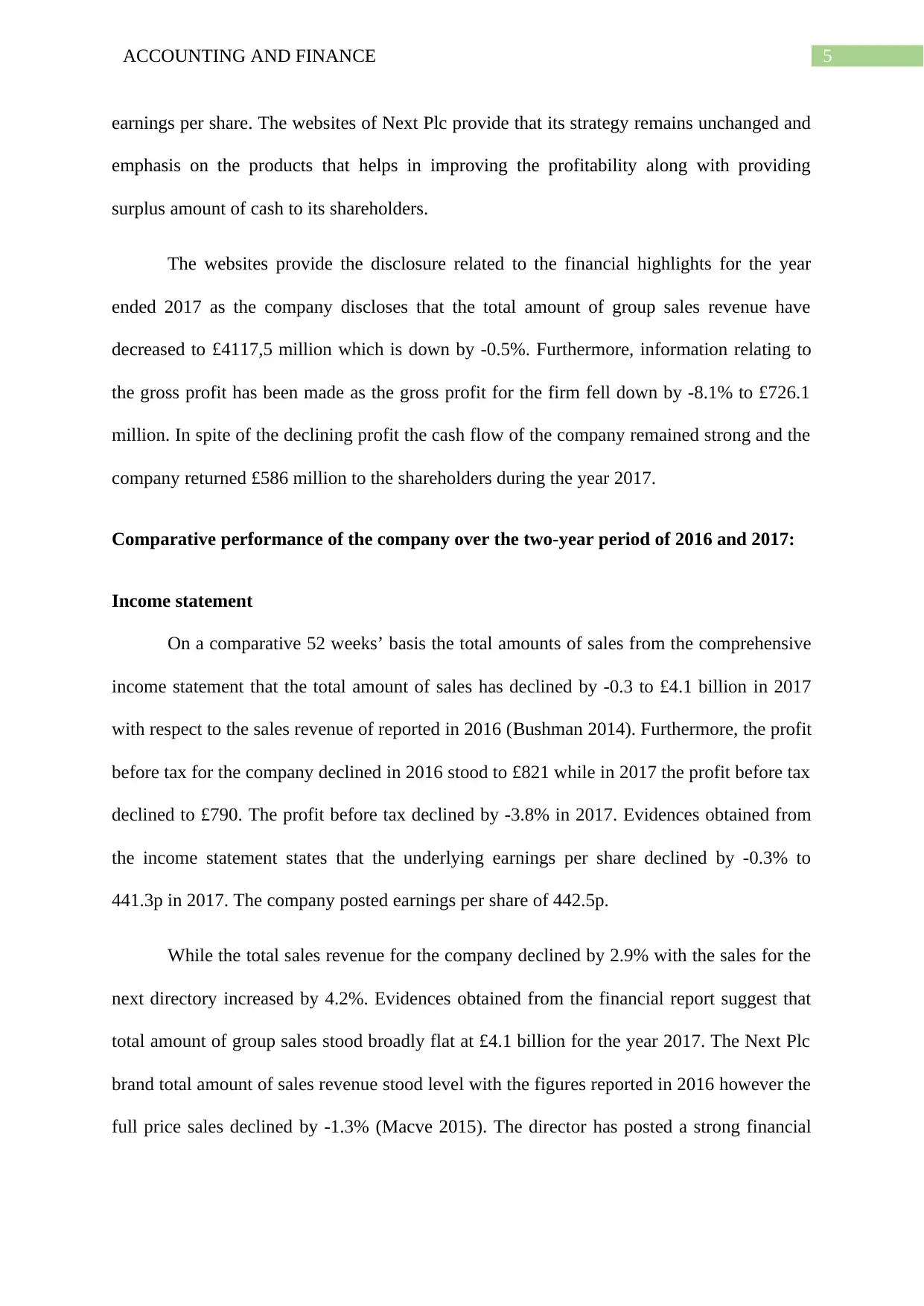
5ACCOUNTING AND FINANCE
earnings per share. The websites of Next Plc provide that its strategy remains unchanged and
emphasis on the products that helps in improving the profitability along with providing
surplus amount of cash to its shareholders.
The websites provide the disclosure related to the financial highlights for the year
ended 2017 as the company discloses that the total amount of group sales revenue have
decreased to £4117,5 million which is down by -0.5%. Furthermore, information relating to
the gross profit has been made as the gross profit for the firm fell down by -8.1% to £726.1
million. In spite of the declining profit the cash flow of the company remained strong and the
company returned £586 million to the shareholders during the year 2017.
Comparative performance of the company over the two-year period of 2016 and 2017:
Income statement
On a comparative 52 weeks’ basis the total amounts of sales from the comprehensive
income statement that the total amount of sales has declined by -0.3 to £4.1 billion in 2017
with respect to the sales revenue of reported in 2016 (Bushman 2014). Furthermore, the profit
before tax for the company declined in 2016 stood to £821 while in 2017 the profit before tax
declined to £790. The profit before tax declined by -3.8% in 2017. Evidences obtained from
the income statement states that the underlying earnings per share declined by -0.3% to
441.3p in 2017. The company posted earnings per share of 442.5p.
While the total sales revenue for the company declined by 2.9% with the sales for the
next directory increased by 4.2%. Evidences obtained from the financial report suggest that
total amount of group sales stood broadly flat at £4.1 billion for the year 2017. The Next Plc
brand total amount of sales revenue stood level with the figures reported in 2016 however the
full price sales declined by -1.3% (Macve 2015). The director has posted a strong financial
earnings per share. The websites of Next Plc provide that its strategy remains unchanged and
emphasis on the products that helps in improving the profitability along with providing
surplus amount of cash to its shareholders.
The websites provide the disclosure related to the financial highlights for the year
ended 2017 as the company discloses that the total amount of group sales revenue have
decreased to £4117,5 million which is down by -0.5%. Furthermore, information relating to
the gross profit has been made as the gross profit for the firm fell down by -8.1% to £726.1
million. In spite of the declining profit the cash flow of the company remained strong and the
company returned £586 million to the shareholders during the year 2017.
Comparative performance of the company over the two-year period of 2016 and 2017:
Income statement
On a comparative 52 weeks’ basis the total amounts of sales from the comprehensive
income statement that the total amount of sales has declined by -0.3 to £4.1 billion in 2017
with respect to the sales revenue of reported in 2016 (Bushman 2014). Furthermore, the profit
before tax for the company declined in 2016 stood to £821 while in 2017 the profit before tax
declined to £790. The profit before tax declined by -3.8% in 2017. Evidences obtained from
the income statement states that the underlying earnings per share declined by -0.3% to
441.3p in 2017. The company posted earnings per share of 442.5p.
While the total sales revenue for the company declined by 2.9% with the sales for the
next directory increased by 4.2%. Evidences obtained from the financial report suggest that
total amount of group sales stood broadly flat at £4.1 billion for the year 2017. The Next Plc
brand total amount of sales revenue stood level with the figures reported in 2016 however the
full price sales declined by -1.3% (Macve 2015). The director has posted a strong financial
⊘ This is a preview!⊘
Do you want full access?
Subscribe today to unlock all pages.

Trusted by 1+ million students worldwide
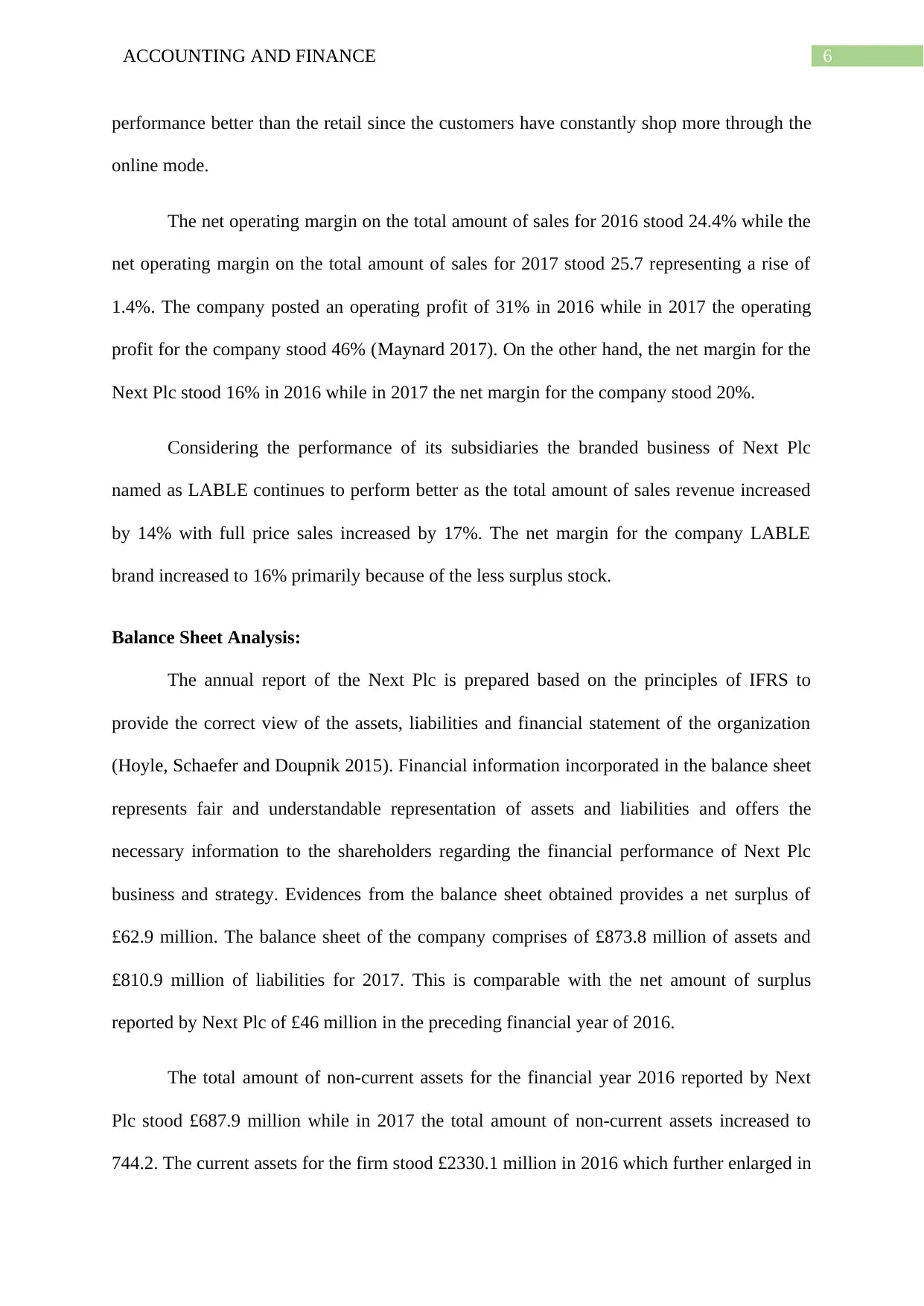
6ACCOUNTING AND FINANCE
performance better than the retail since the customers have constantly shop more through the
online mode.
The net operating margin on the total amount of sales for 2016 stood 24.4% while the
net operating margin on the total amount of sales for 2017 stood 25.7 representing a rise of
1.4%. The company posted an operating profit of 31% in 2016 while in 2017 the operating
profit for the company stood 46% (Maynard 2017). On the other hand, the net margin for the
Next Plc stood 16% in 2016 while in 2017 the net margin for the company stood 20%.
Considering the performance of its subsidiaries the branded business of Next Plc
named as LABLE continues to perform better as the total amount of sales revenue increased
by 14% with full price sales increased by 17%. The net margin for the company LABLE
brand increased to 16% primarily because of the less surplus stock.
Balance Sheet Analysis:
The annual report of the Next Plc is prepared based on the principles of IFRS to
provide the correct view of the assets, liabilities and financial statement of the organization
(Hoyle, Schaefer and Doupnik 2015). Financial information incorporated in the balance sheet
represents fair and understandable representation of assets and liabilities and offers the
necessary information to the shareholders regarding the financial performance of Next Plc
business and strategy. Evidences from the balance sheet obtained provides a net surplus of
£62.9 million. The balance sheet of the company comprises of £873.8 million of assets and
£810.9 million of liabilities for 2017. This is comparable with the net amount of surplus
reported by Next Plc of £46 million in the preceding financial year of 2016.
The total amount of non-current assets for the financial year 2016 reported by Next
Plc stood £687.9 million while in 2017 the total amount of non-current assets increased to
744.2. The current assets for the firm stood £2330.1 million in 2016 which further enlarged in
performance better than the retail since the customers have constantly shop more through the
online mode.
The net operating margin on the total amount of sales for 2016 stood 24.4% while the
net operating margin on the total amount of sales for 2017 stood 25.7 representing a rise of
1.4%. The company posted an operating profit of 31% in 2016 while in 2017 the operating
profit for the company stood 46% (Maynard 2017). On the other hand, the net margin for the
Next Plc stood 16% in 2016 while in 2017 the net margin for the company stood 20%.
Considering the performance of its subsidiaries the branded business of Next Plc
named as LABLE continues to perform better as the total amount of sales revenue increased
by 14% with full price sales increased by 17%. The net margin for the company LABLE
brand increased to 16% primarily because of the less surplus stock.
Balance Sheet Analysis:
The annual report of the Next Plc is prepared based on the principles of IFRS to
provide the correct view of the assets, liabilities and financial statement of the organization
(Hoyle, Schaefer and Doupnik 2015). Financial information incorporated in the balance sheet
represents fair and understandable representation of assets and liabilities and offers the
necessary information to the shareholders regarding the financial performance of Next Plc
business and strategy. Evidences from the balance sheet obtained provides a net surplus of
£62.9 million. The balance sheet of the company comprises of £873.8 million of assets and
£810.9 million of liabilities for 2017. This is comparable with the net amount of surplus
reported by Next Plc of £46 million in the preceding financial year of 2016.
The total amount of non-current assets for the financial year 2016 reported by Next
Plc stood £687.9 million while in 2017 the total amount of non-current assets increased to
744.2. The current assets for the firm stood £2330.1 million in 2016 which further enlarged in
Paraphrase This Document
Need a fresh take? Get an instant paraphrase of this document with our AI Paraphraser
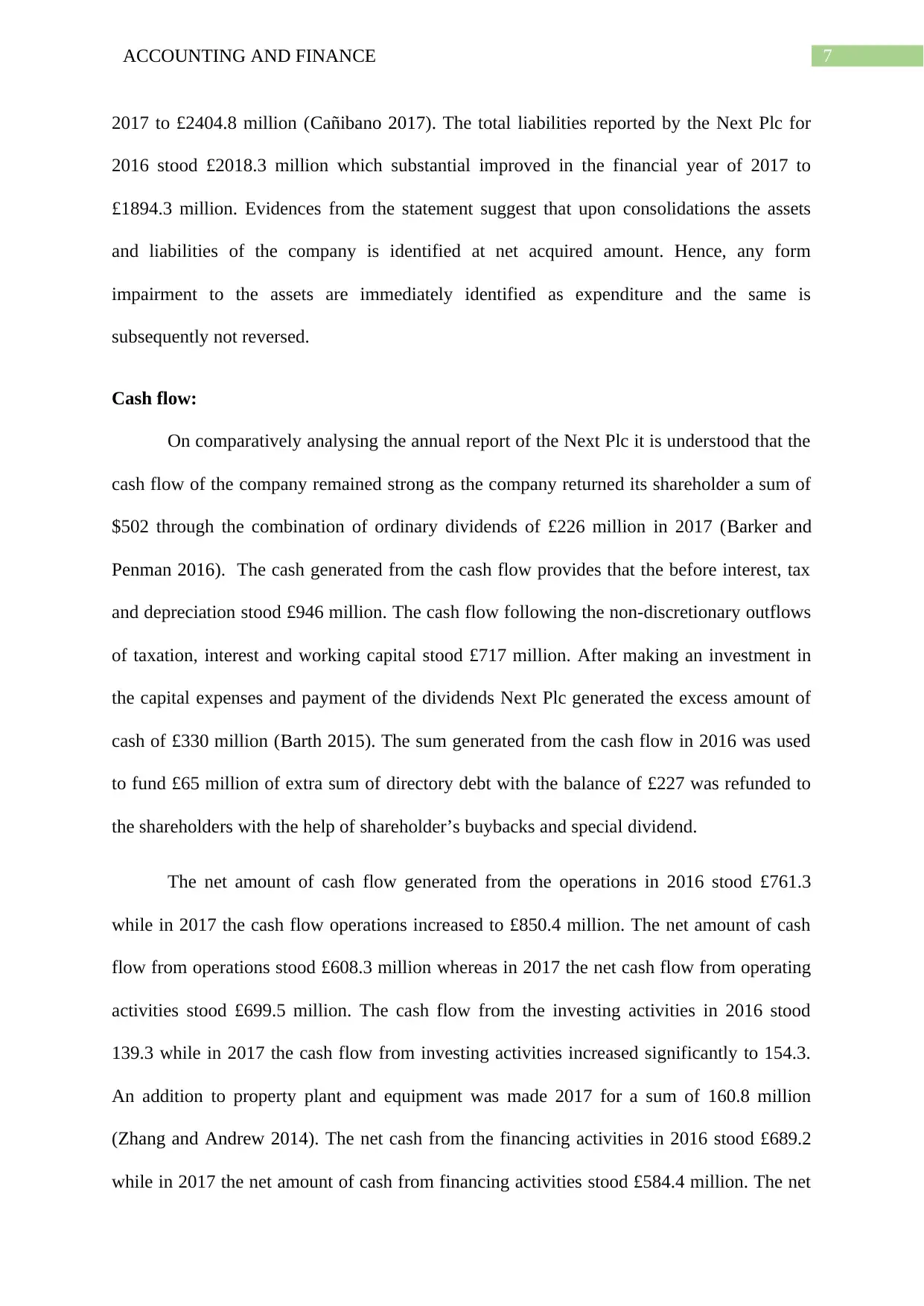
7ACCOUNTING AND FINANCE
2017 to £2404.8 million (Cañibano 2017). The total liabilities reported by the Next Plc for
2016 stood £2018.3 million which substantial improved in the financial year of 2017 to
£1894.3 million. Evidences from the statement suggest that upon consolidations the assets
and liabilities of the company is identified at net acquired amount. Hence, any form
impairment to the assets are immediately identified as expenditure and the same is
subsequently not reversed.
Cash flow:
On comparatively analysing the annual report of the Next Plc it is understood that the
cash flow of the company remained strong as the company returned its shareholder a sum of
$502 through the combination of ordinary dividends of £226 million in 2017 (Barker and
Penman 2016). The cash generated from the cash flow provides that the before interest, tax
and depreciation stood £946 million. The cash flow following the non-discretionary outflows
of taxation, interest and working capital stood £717 million. After making an investment in
the capital expenses and payment of the dividends Next Plc generated the excess amount of
cash of £330 million (Barth 2015). The sum generated from the cash flow in 2016 was used
to fund £65 million of extra sum of directory debt with the balance of £227 was refunded to
the shareholders with the help of shareholder’s buybacks and special dividend.
The net amount of cash flow generated from the operations in 2016 stood £761.3
while in 2017 the cash flow operations increased to £850.4 million. The net amount of cash
flow from operations stood £608.3 million whereas in 2017 the net cash flow from operating
activities stood £699.5 million. The cash flow from the investing activities in 2016 stood
139.3 while in 2017 the cash flow from investing activities increased significantly to 154.3.
An addition to property plant and equipment was made 2017 for a sum of 160.8 million
(Zhang and Andrew 2014). The net cash from the financing activities in 2016 stood £689.2
while in 2017 the net amount of cash from financing activities stood £584.4 million. The net
2017 to £2404.8 million (Cañibano 2017). The total liabilities reported by the Next Plc for
2016 stood £2018.3 million which substantial improved in the financial year of 2017 to
£1894.3 million. Evidences from the statement suggest that upon consolidations the assets
and liabilities of the company is identified at net acquired amount. Hence, any form
impairment to the assets are immediately identified as expenditure and the same is
subsequently not reversed.
Cash flow:
On comparatively analysing the annual report of the Next Plc it is understood that the
cash flow of the company remained strong as the company returned its shareholder a sum of
$502 through the combination of ordinary dividends of £226 million in 2017 (Barker and
Penman 2016). The cash generated from the cash flow provides that the before interest, tax
and depreciation stood £946 million. The cash flow following the non-discretionary outflows
of taxation, interest and working capital stood £717 million. After making an investment in
the capital expenses and payment of the dividends Next Plc generated the excess amount of
cash of £330 million (Barth 2015). The sum generated from the cash flow in 2016 was used
to fund £65 million of extra sum of directory debt with the balance of £227 was refunded to
the shareholders with the help of shareholder’s buybacks and special dividend.
The net amount of cash flow generated from the operations in 2016 stood £761.3
while in 2017 the cash flow operations increased to £850.4 million. The net amount of cash
flow from operations stood £608.3 million whereas in 2017 the net cash flow from operating
activities stood £699.5 million. The cash flow from the investing activities in 2016 stood
139.3 while in 2017 the cash flow from investing activities increased significantly to 154.3.
An addition to property plant and equipment was made 2017 for a sum of 160.8 million
(Zhang and Andrew 2014). The net cash from the financing activities in 2016 stood £689.2
while in 2017 the net amount of cash from financing activities stood £584.4 million. The net
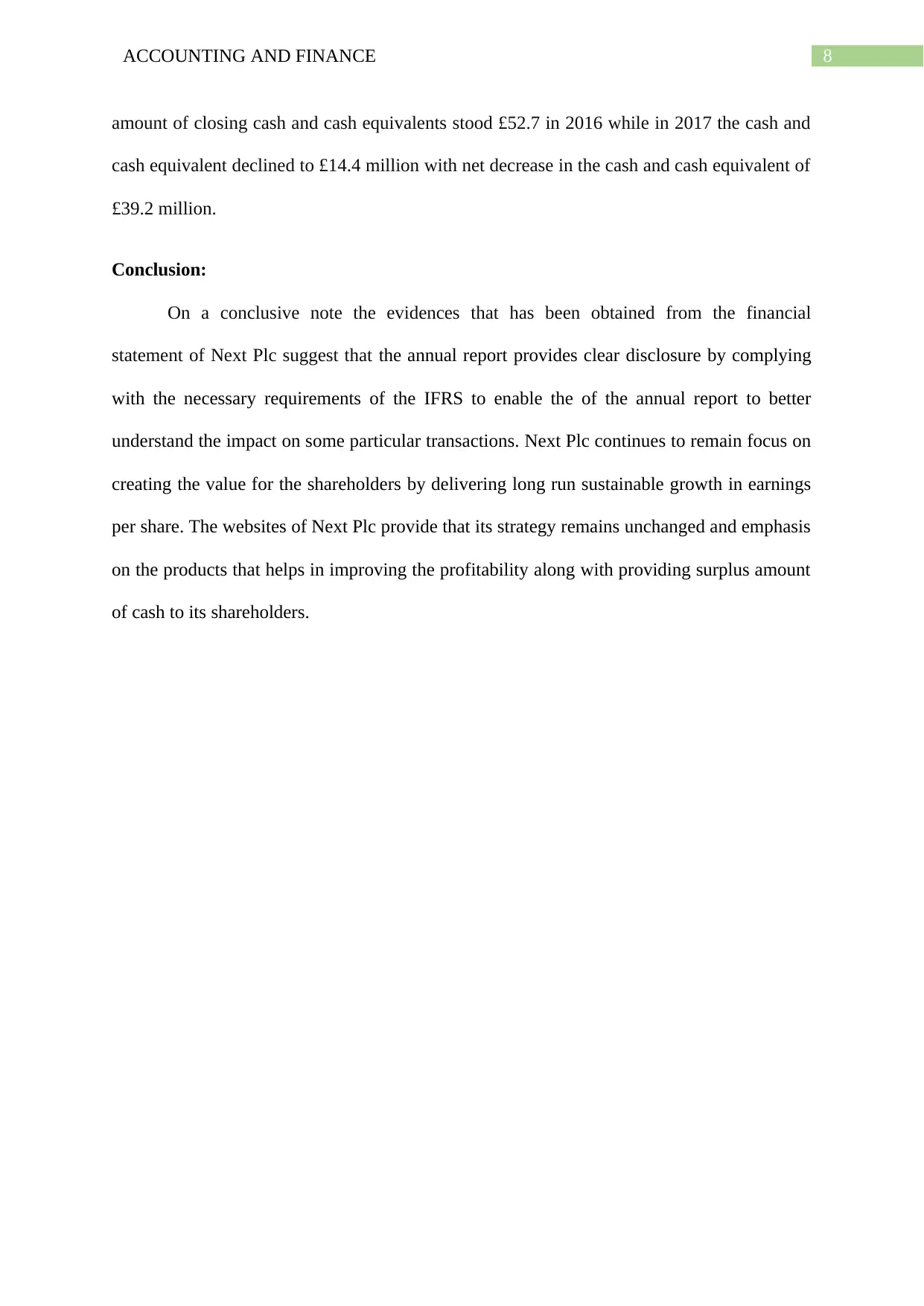
8ACCOUNTING AND FINANCE
amount of closing cash and cash equivalents stood £52.7 in 2016 while in 2017 the cash and
cash equivalent declined to £14.4 million with net decrease in the cash and cash equivalent of
£39.2 million.
Conclusion:
On a conclusive note the evidences that has been obtained from the financial
statement of Next Plc suggest that the annual report provides clear disclosure by complying
with the necessary requirements of the IFRS to enable the of the annual report to better
understand the impact on some particular transactions. Next Plc continues to remain focus on
creating the value for the shareholders by delivering long run sustainable growth in earnings
per share. The websites of Next Plc provide that its strategy remains unchanged and emphasis
on the products that helps in improving the profitability along with providing surplus amount
of cash to its shareholders.
amount of closing cash and cash equivalents stood £52.7 in 2016 while in 2017 the cash and
cash equivalent declined to £14.4 million with net decrease in the cash and cash equivalent of
£39.2 million.
Conclusion:
On a conclusive note the evidences that has been obtained from the financial
statement of Next Plc suggest that the annual report provides clear disclosure by complying
with the necessary requirements of the IFRS to enable the of the annual report to better
understand the impact on some particular transactions. Next Plc continues to remain focus on
creating the value for the shareholders by delivering long run sustainable growth in earnings
per share. The websites of Next Plc provide that its strategy remains unchanged and emphasis
on the products that helps in improving the profitability along with providing surplus amount
of cash to its shareholders.
⊘ This is a preview!⊘
Do you want full access?
Subscribe today to unlock all pages.

Trusted by 1+ million students worldwide
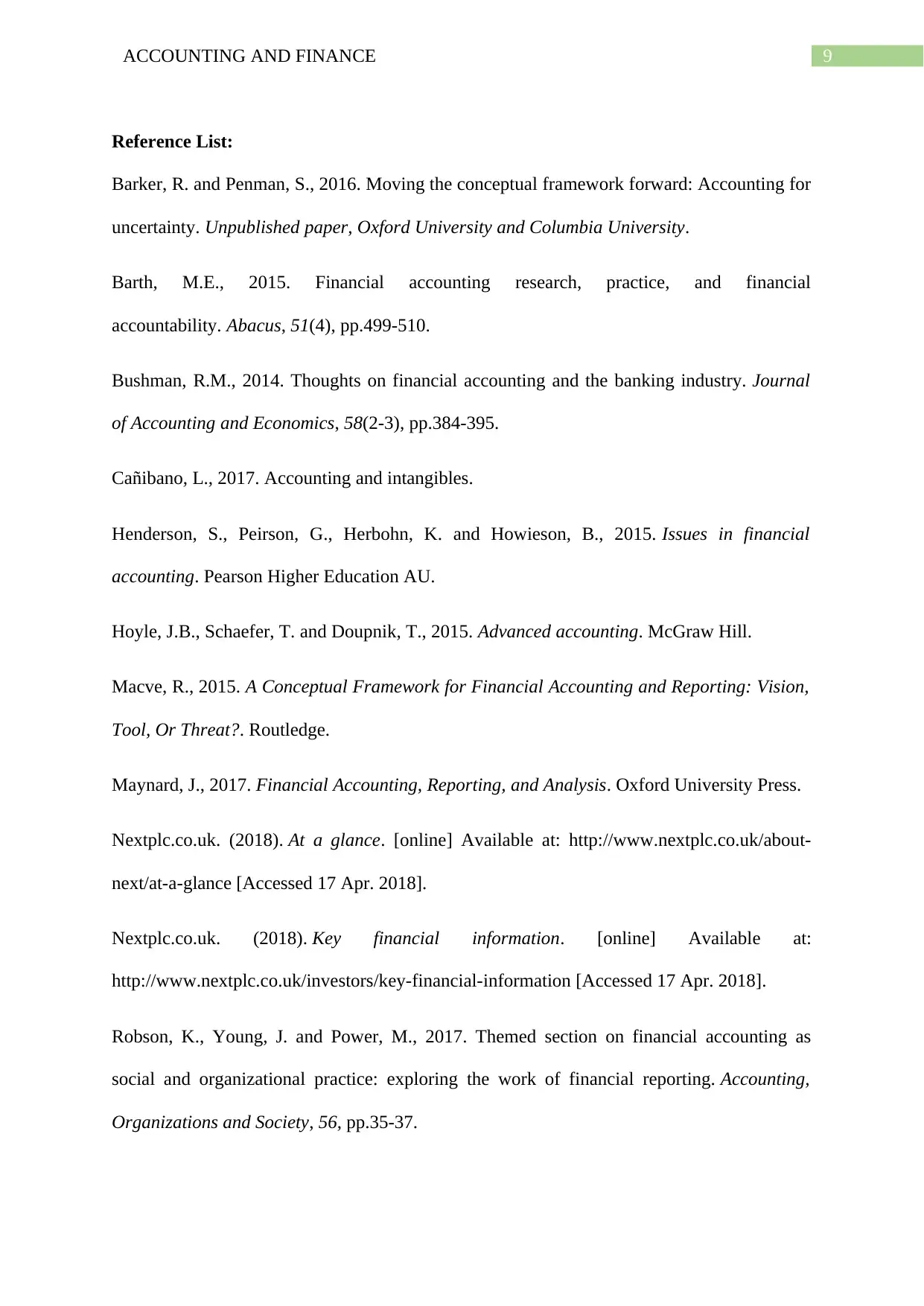
9ACCOUNTING AND FINANCE
Reference List:
Barker, R. and Penman, S., 2016. Moving the conceptual framework forward: Accounting for
uncertainty. Unpublished paper, Oxford University and Columbia University.
Barth, M.E., 2015. Financial accounting research, practice, and financial
accountability. Abacus, 51(4), pp.499-510.
Bushman, R.M., 2014. Thoughts on financial accounting and the banking industry. Journal
of Accounting and Economics, 58(2-3), pp.384-395.
Cañibano, L., 2017. Accounting and intangibles.
Henderson, S., Peirson, G., Herbohn, K. and Howieson, B., 2015. Issues in financial
accounting. Pearson Higher Education AU.
Hoyle, J.B., Schaefer, T. and Doupnik, T., 2015. Advanced accounting. McGraw Hill.
Macve, R., 2015. A Conceptual Framework for Financial Accounting and Reporting: Vision,
Tool, Or Threat?. Routledge.
Maynard, J., 2017. Financial Accounting, Reporting, and Analysis. Oxford University Press.
Nextplc.co.uk. (2018). At a glance. [online] Available at: http://www.nextplc.co.uk/about-
next/at-a-glance [Accessed 17 Apr. 2018].
Nextplc.co.uk. (2018). Key financial information. [online] Available at:
http://www.nextplc.co.uk/investors/key-financial-information [Accessed 17 Apr. 2018].
Robson, K., Young, J. and Power, M., 2017. Themed section on financial accounting as
social and organizational practice: exploring the work of financial reporting. Accounting,
Organizations and Society, 56, pp.35-37.
Reference List:
Barker, R. and Penman, S., 2016. Moving the conceptual framework forward: Accounting for
uncertainty. Unpublished paper, Oxford University and Columbia University.
Barth, M.E., 2015. Financial accounting research, practice, and financial
accountability. Abacus, 51(4), pp.499-510.
Bushman, R.M., 2014. Thoughts on financial accounting and the banking industry. Journal
of Accounting and Economics, 58(2-3), pp.384-395.
Cañibano, L., 2017. Accounting and intangibles.
Henderson, S., Peirson, G., Herbohn, K. and Howieson, B., 2015. Issues in financial
accounting. Pearson Higher Education AU.
Hoyle, J.B., Schaefer, T. and Doupnik, T., 2015. Advanced accounting. McGraw Hill.
Macve, R., 2015. A Conceptual Framework for Financial Accounting and Reporting: Vision,
Tool, Or Threat?. Routledge.
Maynard, J., 2017. Financial Accounting, Reporting, and Analysis. Oxford University Press.
Nextplc.co.uk. (2018). At a glance. [online] Available at: http://www.nextplc.co.uk/about-
next/at-a-glance [Accessed 17 Apr. 2018].
Nextplc.co.uk. (2018). Key financial information. [online] Available at:
http://www.nextplc.co.uk/investors/key-financial-information [Accessed 17 Apr. 2018].
Robson, K., Young, J. and Power, M., 2017. Themed section on financial accounting as
social and organizational practice: exploring the work of financial reporting. Accounting,
Organizations and Society, 56, pp.35-37.
Paraphrase This Document
Need a fresh take? Get an instant paraphrase of this document with our AI Paraphraser
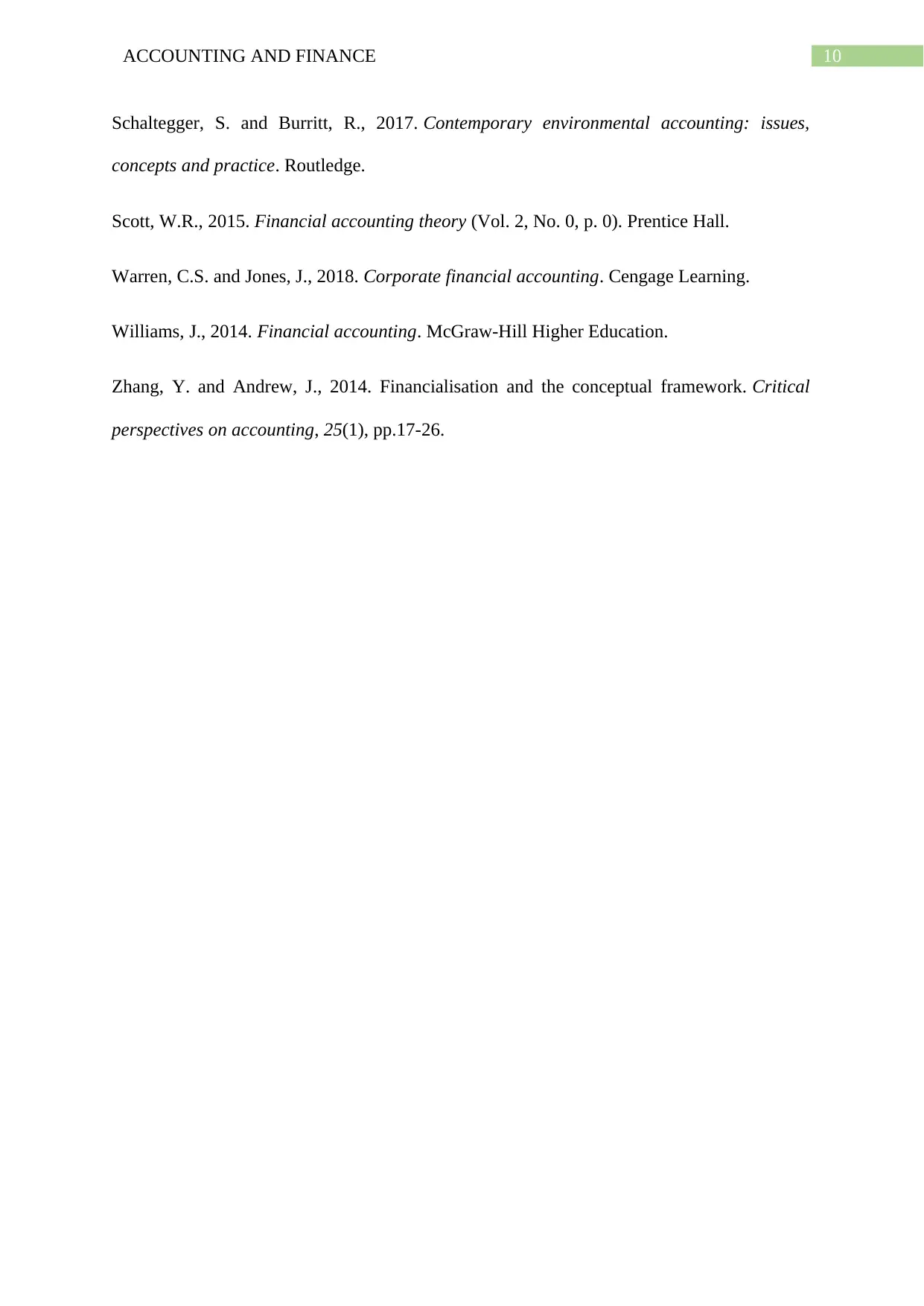
10ACCOUNTING AND FINANCE
Schaltegger, S. and Burritt, R., 2017. Contemporary environmental accounting: issues,
concepts and practice. Routledge.
Scott, W.R., 2015. Financial accounting theory (Vol. 2, No. 0, p. 0). Prentice Hall.
Warren, C.S. and Jones, J., 2018. Corporate financial accounting. Cengage Learning.
Williams, J., 2014. Financial accounting. McGraw-Hill Higher Education.
Zhang, Y. and Andrew, J., 2014. Financialisation and the conceptual framework. Critical
perspectives on accounting, 25(1), pp.17-26.
Schaltegger, S. and Burritt, R., 2017. Contemporary environmental accounting: issues,
concepts and practice. Routledge.
Scott, W.R., 2015. Financial accounting theory (Vol. 2, No. 0, p. 0). Prentice Hall.
Warren, C.S. and Jones, J., 2018. Corporate financial accounting. Cengage Learning.
Williams, J., 2014. Financial accounting. McGraw-Hill Higher Education.
Zhang, Y. and Andrew, J., 2014. Financialisation and the conceptual framework. Critical
perspectives on accounting, 25(1), pp.17-26.
1 out of 11
Related Documents
Your All-in-One AI-Powered Toolkit for Academic Success.
+13062052269
info@desklib.com
Available 24*7 on WhatsApp / Email
![[object Object]](/_next/static/media/star-bottom.7253800d.svg)
Unlock your academic potential
Copyright © 2020–2025 A2Z Services. All Rights Reserved. Developed and managed by ZUCOL.





